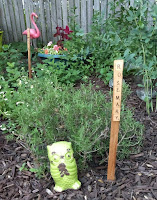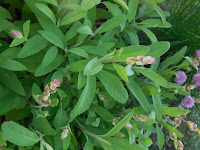Whether
you are a gardener who enjoys a cocktail now and then or a mixologist tired of
spending money on ingredients with an all-too-short shelf life, growing your
own herbs to use in your favorite mixed drinks is fun and easy.
I crafted a program on using herbs for cocktails (called Crafting Herbal Mocktails) and as a result have experimented with ways to incorporate fresh and dried herbs into mixed drinks or alcohol-free cocktails. And you too can make your own herb enhanced drinks with just a few herbs. If you grow in just a couple of planter boxes, a hodge podge of pots of varying sizes or in a garden patch or raised bed you can add a few herbs and start experimenting.
To try: Rosemary Lemon Vodka
How to grow it: Great in a rock garden and dry areas, raise from seed or cutting, but if you want to harvest the first year, get yourself a nursery plant to get a head start with this perennial that is slow to get going.
To try: Pear and Thyme Fizz
To Try: Lavender Collins
I crafted a program on using herbs for cocktails (called Crafting Herbal Mocktails) and as a result have experimented with ways to incorporate fresh and dried herbs into mixed drinks or alcohol-free cocktails. And you too can make your own herb enhanced drinks with just a few herbs. If you grow in just a couple of planter boxes, a hodge podge of pots of varying sizes or in a garden patch or raised bed you can add a few herbs and start experimenting.
Realize
you are not distilling your own spirits, but crafting flavorings and infusing existing
spirits with the unique flavor of herbs is easy and fun. Selecting herbs to grow can transform
cocktail hour into an irresistible exercise in gardening as herbs make their
way from planter box to martini, collins or rocks glass.
If you are interested in Cocktails or Mocktails I have posted several recipes in the past and you can search the blog or chose the links above.
Here
are my picks for the 7 Best herbs to grow for cocktail making:
Mint
Flavor: Cool and
refreshing. Depending on what type you grow, some have citrus tones, other are
floral or spicy. Kentucky Colonel or Mojito mint are good choices for growing
in a cocktail garden.
How
to use it:
Mint is probably the most commonly used fresh herb for cocktails. Mojitos and
juleps are well known for using mint, but this refreshing leaf brightens flavor
wherever it is used. Muddled or used as a garnish or infusion, mint is a
winning choice for the gardener’s cocktail. And simple syrup can be used to
make non-alcoholic ades or to flavor teas.
How
to grow it:
Mint grows like a weed. Plant in containers or in the yard (if you are prepared
to have a lot of it).
To try: Nojito Mint Mojito-Style Mocktail
To try: Nojito Mint Mojito-Style Mocktail
Rosemary
Flavor: Rosemary looks like clippings from a pine tree with a taste to match.
How
to use it:
Great as a garnish where just a hint of its flavor pops in to visit. The rich,
woody flavor of rosemary can be added whole or muddled as a featured player in
gin or vodka or to add pronounced depth to bourbon. Try adding a sprig to your
next gin and tonic or whiskey sour. Enjoy it in a punch with sweeter flavor to give a savory hint. It can also be used to craft a Gin substitute.
How
to grow it:
Start from cuttings in a pot placed in a sunny spot. Rosemary stands up well in
drought conditions, and should be brought in for winter in colder climates.
To try: Rosemary Lemon Vodka
Thyme
Flavor: Can be sweet to
savory depending on the variety but for cocktails common garden thyme is a good
choice. It provides a robust earthy flavor with a hint of lemon and mint and a subtle
undertone of pepper.
How
to use it:
A simple syrup made with thyme makes it a great companion to any gin-based drink. And using the simple syrup to create a fun fizz made with prosecco or a liqueur-based cocktail with
Grand Marnier gives your cocktail hour variety.
How to grow it: Great in a rock garden and dry areas, raise from seed or cutting, but if you want to harvest the first year, get yourself a nursery plant to get a head start with this perennial that is slow to get going.
To try: Pear and Thyme Fizz
Basil
Flavor: Currently a
fashionable herb in the cocktail scene, different varieties of this complex,
aromatic herb can lean sweet, peppery or citrus-y with clove or licorice overtones.
How
to use it:
Like mint, basil is a great all-purpose herb, adding great flavor to gin,
tequila or rum drinks among others. Muddle, use as a garnish or craft a simple
syrup to use in cocktails as a change of pace from the same old cocktail. For some great color, use a purple basil.
How
to grow it:
Make sure basil plants get plenty of water and sunlight. Harvest leaves from
the top a few at a time so the plant will have continued healthy growth
throughout the summer and beyond. Start from seed or get a jump start with a
nursery plant.
To try: Pineapple Basil Gin Cocktail
To try: Pineapple Basil Gin Cocktail
 Lavender
Lavender
Flavor: Floral and woody
with undertones similar to mint and rosemary, lavender is wonderfully
distinctive, but a little goes a long way.
How
to use it:
Perhaps best prepared in a simple syrup, lavender is the taste of springtime in
front porch drinks featuring vodka, gin or even lemonade for the non-drinker. But sprigs make a great garnish, and sugared stems are wonderful stirred into a drink.
How
to grow it:
A great container plant. Water deeply, but make sure it has good drainage and
gets plenty of sunlight. Harvest as blossoms begin to open. It likes a well drained soil. Hard to grow from seed, so get a plant from the shops or divide an existing plant from a freind.
To Try: Lavender Collins
Lemon Grass
Flavor: light citrus to
lemon overtones with a hint of sweet mint combined with an intoxicating lemon
scent.
How
to use it:
Lemon grass is used both for its lemon flavor as well as its amazing aroma it
adds great dimension to flavoring vodka, as well as a simple syrup to make
lemonade based drinks or complex citrus cocktails with gin, whiskey or
sparkling wines.
How
to grow it:
An annual in cooler climates grow in a container as an accent plant or in the ground
as a focal item as it has a tall spreading grass look that fans out. It needs little care except regular water and
well-drained soil. Propagate by seed or root division.
To try: Mint and Lemongrass Cooler
To try: Mint and Lemongrass Cooler
Sage
Flavor: Earthy, woody
and vaguely peppery, sage has a wonderful and distinctive flavor, but should be
used sparingly.
How
to use it:
Muddled, infused into spirits or prepared in a simple syrup, sage adds savory
complexity to mixed drinks, but the flavor can be overpowering for some. Try it in tequila or add
some sage to your next gin fizz for a summer drink with unmistakable garden
taste. A salt infused with sage is great savory glass rim.
How
to grow it:
Requires little care and is tolerant of different soil types and conditions,
but soil should be well-drained. Can be started from seed, cutting or division of an existing plant. Keep well trimmed to avoid woodiness.
To try: Tequila Sage Smash from cakenknife.com
To try: Tequila Sage Smash from cakenknife.com






No comments:
Post a Comment